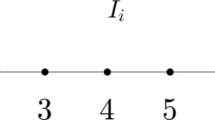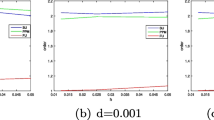Abstract
Meshfree methods based on radial basis function (RBF) approximation are of interest for numerical solution of partial differential equations (PDEs) because they are flexible with respect to geometry, they can provide high order convergence, they allow for local refinement, and they are easy to implement in higher dimensions. For global RBF methods, one of the major disadvantages is the computational cost associated with the dense linear systems that arise. Therefore, research is currently directed towards localized RBF approximations such as the RBF partition of unity collocation method (RBF–PUM) proposed here. The objective of this paper is to establish that RBF–PUM is viable for parabolic PDEs of convection–diffusion type. The stability and accuracy of RBF–PUM is investigated partly theoretically and partly numerically. Numerical experiments show that high-order algebraic convergence can be achieved for convection–diffusion problems. Numerical comparisons with finite difference and pseudospectral methods have been performed, showing that RBF–PUM is competitive with respect to accuracy, and in some cases also with respect to computational time. As an application, RBF–PUM is employed for a two-dimensional American option pricing problem. It is shown that using a node layout that captures the solution features improves the accuracy significantly compared with a uniform node distribution.


















Similar content being viewed by others
References
Babuška, I., Melenk, J.M.: The partition of unity method. Int. J. Numer. Methods Eng. 40(4), 727–758 (1997). doi:10.1002/(SICI)1097-0207(19970228)40:4<727::AID-NME86>3.0.CO;2-N
Ballestra, L.V., Pacelli, G.: Computing the survival probability density function in jump-diffusion models: a new approach based on radial basis functions. Eng. Anal. Bound. Elem. 35(9), 1075–1084 (2011). doi:10.1016/j.enganabound.2011.02.008
Ballestra, L.V., Pacelli, G.: A radial basis function approach to compute the first-passage probability density function in two-dimensional jump-diffusion models for financial and other applications. Eng. Anal. Bound. Elem. 36(11), 1546–1554 (2012). doi:10.1016/j.enganabound.2012.04.011
Ballestra, L.V., Pacelli, G.: Pricing European and American options with two stochastic factors: A highly efficient radial basis function approach. J. Econ. Dyn. Control 37(6), 1142–1167 (2013). doi:10.1016/j.jedc.2013.01.013
Bates, D.: Jumps and stochastic volatility: exchange rate processes implicit in deutsche mark options. Rev. Financ. Stud. 9(1), 69–107 (1996). doi:10.1093/rfs/9.1.69
Black, F., Scholes, M.: The pricing of options and corporate liabilities. J. Polit. Econ. 81(3), 637–654 (1973)
Carr, P., Geman, H., Madan, D.B., Yor, M.: Stochastic volatility for Lévy processes. Math. Financ. 13(3), 345–382 (2003). doi:10.1111/1467-9965.00020
Duffie, D.: Dynamic Asset Pricing Theory. Princeton University Press, Princeton (1996)
Durham, G.B., Gallant, A.R.: Numerical techniques for maximum likelihood estimation of continuous-time diffusion processes. J. Bus. Econ. Stat. 20(3), 297–338 (2002). doi:10.1198/073500102288618397
Fasshauer, G., Khaliq, A.Q.M., Voss, D.A.: Using meshfree approximation for multi asset American options. J. Chin. Inst. Eng. 27(4), 563–571 (2004). doi:10.1080/02533839.2004.9670904
Fasshauer, G.E.: Meshfree Approximation Methods with MATLAB. Interdisciplinary Mathematical Sciences, vol. 6, pp. xviii+500. World Scientific Publishing Co. Pte. Ltd., Hackensack, NJ (2007)
Fichera, G.: Sulle equazioni differenziali lineari ellittico-paraboliche del secondo ordine. Atti Accad. Naz. Lincei. Mem. Cl. Sci. Fis. Mat. Nat. Sez. I. VIII, ser. 5, pp. 3–30 (1956)
Fornberg, B., Larsson, E., Flyer, N.: Stable computations with Gaussian radial basis functions. SIAM J. Sci. Comput. 33(2), 869–892 (2011). doi:10.1137/09076756X
Fornberg, B., Zuev, J.: The Runge phenomenon and spatially variable shape parameters in RBF interpolation. Comput. Math. Appl. 54(3), 379–398 (2007). doi:10.1016/j.camwa.2007.01.028
Franke, R., Nielson, G.: Smooth interpolation of large sets of scattered data. Int. J. Numer. Methods Eng. 15(11), 1691–1704 (1980). doi:10.1002/nme.1620151110
Halton, J.H.: On the efficiency of certain quasi-random sequences of points in evaluating multi-dimensional integrals. Numer. Math. 2(1), 84–90 (1960). doi:10.1007/BF01386213
Hon, Y.C., Mao, X.Z.: A radial basis function method for solving options pricing models. J. Financ. Eng. 8, 31–49 (1999)
In’t Hout, K.J., Foulon, S.: ADI finite difference schemes for option pricing in the Heston model with correlation. Int. J. Numer. Anal. Model. 7(2), 303–320 (2010)
Ito, K., Toivanen, J.: Lagrange multiplier approach with optimized finite difference stencils for pricing American options under stochastic volatility. SIAM J. Sci. Comput. 31(4), 2646–2664 (2009). doi:10.1137/07070574X
Janson, S., Tysk, J.: Feynman–Kac formulas for Black–Scholes-type operators. Bull. Lond. Math. Soc. 38(2), 269–282 (2006). doi:10.1112/S0024609306018194
Kangro, R., Nicolaides, R.: Far field boundary conditions for Black–Scholes equations. SIAM J. Numer. Anal. 38(4), 1357–1368 (2000). doi:10.1137/S0036142999355921.
Kou, S.G.: A jump-diffusion model for option pricing. Manag. Sci. 48(8), 1086–1101 (2002)
Kwok, Y.K.: Mathematical Models of Financial Derivatives, 2nd edn. Springer, Berlin (2008)
Larsson, E., Fornberg, B.: Theoretical and computational aspects of multivariate interpolation with increasingly flat radial basis functions. Comput. Math. Appl. 49(1), 103–130 (2005). doi:10.1016/j.camwa.2005.01.010
Larsson, E., Gomes, S., Heryudono, A., Safdari-Vaighani, A.: Radial basis function methods in computational finance. In: Proceedings of the CMMSE 2013, p. 12, Almería, Spain (2013)
Larsson, E., Heryudono, A.: A partition of unity radial basis function collocation method for partial differential equations (2015, in preparation)
Larsson, E., Lehto, E., Heryudono, A., Fornberg, B.: Stable computation of differentiation matrices and scattered node stencils based on Gaussian radial basis functions. SIAM J. Sci. Comput. 35(4), A2096–A2119 (2013). doi:10.1137/120899108
McLain, D.H.: Two dimensional interpolation from random data. Comput. J. 19(2), 178–181 (1976). doi:10.1093/comjnl/19.2.178
Merton, R.C.: Option pricing when underlying stock returns are discontinuous. J. Financ. Econ. 3(1–2), 125–144 (1976). doi:10.1016/0304-405X(76)90022-2
Nielsen, B.F., Skavhaug, O., Tveito, A.: Penalty and front-fixing methods for the numerical solution of American option problems. J. Comput. Financ. 5, 69–97 (2002)
Nielsen, B.F., Skavhaug, O., Tveito, A.: Penalty methods for the numerical solution of American multi-asset option problems. J. Comput. Appl. Math. 222(1), 3–16 (2008). doi:10.1016/j.cam.2007.10.041
Persson, J., von Sydow, L.: Pricing American options using a space–time adaptive finite difference method. Math. Comput. Simulat. 80(9), 1922–1935 (2010). doi:10.1016/j.matcom.2010.02.008
Pettersson, U., Larsson, E., Marcusson, G., Persson, J.: Improved radial basis function methods for multi-dimensional option pricing. J. Comput. Appl. Math. 222(1), 82–93 (2008). doi:10.1016/j.cam.2007.10.038
Platte, R.B.: How fast do radial basis function interpolants of analytic functions converge? IMA J. Numer. Anal. 31(4), 1578–1597 (2011). doi:10.1093/imanum/drq020
Reddy, S.C., Trefethen, L.N.: Stability of the method of lines. Numer. Math. 62(2), 235–267 (1992). doi:10.1007/BF01396228
Rieger, C., Zwicknagl, B.: Sampling inequalities for infinitely smooth functions, with applications to interpolation and machine learning. Adv. Comput. Math. 32(1), 103–129 (2010). doi:10.1007/s10444-008-9089-0
Rieger, C., Zwicknagl, B.: Improved exponential convergence rates by oversampling near the boundary. Constr. Approx. 39(2), 323–341 (2014). doi:10.1007/s00365-013-9211-5
Shepard, D.: A two-dimensional interpolation function for irregularly-spaced data. In: Proceedings of the 1968 23rd ACM National Conference (ACM ‘68), pp. 517–524. ACM, New York, NY (1968)
Tavella, D., Randall, C.: Pricing Financial Instruments. Wiley, New York (2000)
Trefethen, L.N., Embree, M.: Spectra and Pseudospectra: The Behavior of Nonnormal Matrices and Operators. Princeton University Press, Princeton (2005)
Wendland, H.: Piecewise polynomial, positive definite and compactly supported radial functions of minimal degree. Adv. Comput. Math. 4(4), 389–396 (1995). doi:10.1007/BF02123482
Wendland, H.: Fast evaluation of radial basis functions: methods based on partition of unity. In: Approximation Theory X (St. Louis, MO, 2001), pp. 473–483. Vanderbilt University Press, Nashville, TN (2002)
Wright, T.G.: EigTool. http://www.comlab.ox.ac.uk/pseudospectra/eigtool/ (2002)
Wu, Z., Hon, Y.C.: Convergence error estimate in solving free boundary diffusion problem by radial basis functions method. Eng. Anal. Bound. Elem. 27, 73–79 (2003). doi:10.1016/S0955-7997(02)00083-8
Zvan, R., Forsyth, P.A., Vetzal, K.R.: Penalty methods for American options with stochastic volatility. J. Comput. Appl. Math. 91(2), 199–218 (1998). doi:10.1016/S0377-0427(98)00037-5
Acknowledgments
The authors would like to thank Victor Shcherbakov, Uppsala University who provided the FD-operator splitting implementation for the American option pricing problem.
Author information
Authors and Affiliations
Corresponding author
Additional information
The work of the second author was supported in part by Marie Curie Grant FP7 235730, AFOSR Grant FA-9550-12-1-0224, and NSF Grant DMS 1318427.
Rights and permissions
About this article
Cite this article
Safdari-Vaighani, A., Heryudono, A. & Larsson, E. A Radial Basis Function Partition of Unity Collocation Method for Convection–Diffusion Equations Arising in Financial Applications. J Sci Comput 64, 341–367 (2015). https://doi.org/10.1007/s10915-014-9935-9
Received:
Revised:
Accepted:
Published:
Issue Date:
DOI: https://doi.org/10.1007/s10915-014-9935-9
Keywords
- Collocation method
- Meshfree
- Radial basis function
- Partition of unity
- RBF–PUM
- Convection–diffusion equation
- American option




